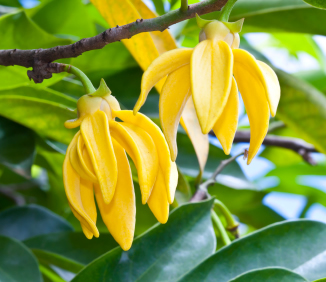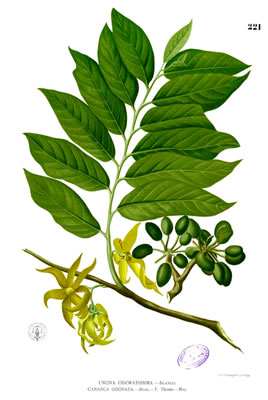Ylang-Ylang Cananga adorata

ylang-ylang flowers
- Common Names
- Ylang-Ylang
- Botanical Name
- Cananga adorata
- Family
- Annonaceae
Medicinal Uses & Benefits of Ylang-Ylang
![]() How to Use|
Side Effects |
Plant & Garden|
Aromatherapy Oil |
How to Use|
Side Effects |
Plant & Garden|
Aromatherapy Oil |
- Medicinal Uses: * Aphrodisiac
* Aromatherapy
* Depression
* Hypertension
* Sleep/Insomnia
- Properties: * Antidepressant * Aphrodisiac * Aromatic * Calm * Communication * Confidence * Emmenagogue * Hypotensive * Mood * Sedative
- Parts Used: essence obtained from flowers
- Constituents: pinene, benzoic acid, cadinene, caryophyllene, cresol, eugenol, isoeugenol, linalyl acetate, linalyl benzoate, linalool, geraniol
How to Use: Ylang-Ylang
Preparation Methods & Dosage :Essential Oil
Ylang-Ylang Remedies
Ylang-Ylang : Essential Oil Profile
Ylang ylang oil is distilled from the early morning, fresh-picked flowers of the cananga tree. The distillation process is interrupted at various points as the accumulated oil is removed, producing the different grades. The first oil to be drawn off is the highest quality and is graded extra or #1. Yang-yang Complete oil represents the total or ‘unfractionated’ oil, but this is sometimes constructed by blending ylang ylang 1 and 2 together. Top grade Ylang ylang has an intense floral, sweet, jasmine-like, almost narcotic sensual, euphoric aroma.
Ylang-Ylang Side Effects: Beware of adulterations with inferior oils. High concentration can cause headache and nausea.
Plant Description
Ylang-ylang, Cananga odorata, is the flower of the native Filipino cananga tree. The tree is found throughout tropical Asia. The leaves are long, smooth and glossy, and the branches droop like a willow. The highly perfumed flower is greenish yellow or pink, curly like a starfish, and yields a highly fragrant essential oil.
Regional Traditions :Southeast Asia *












